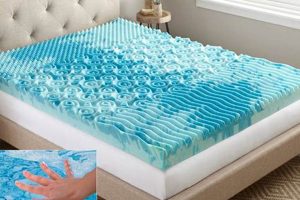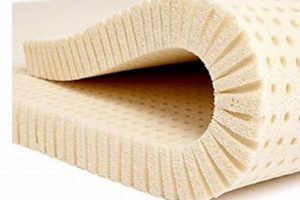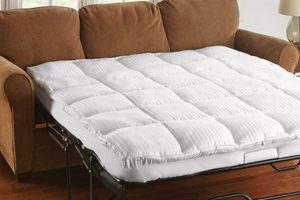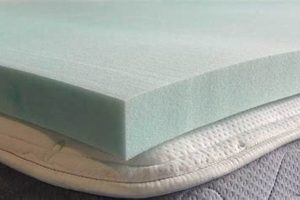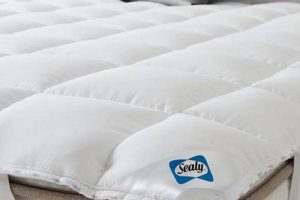The term describes a mattress accessory crafted from latex, designed to overlay a king-sized mattress. This product serves to modify the feel and support characteristics of the underlying mattress. It is typically sized to match the dimensions of a standard king mattress, roughly 76 inches wide by 80 inches long.
Use of such an overlay can provide benefits such as enhanced comfort, pressure relief, and improved spinal alignment. Latex, as a material, offers resilience, durability, and breathability, potentially leading to a cooler and more comfortable sleep experience. The material’s natural properties can also make it a suitable option for individuals with allergies. Historically, the use of mattress toppers has evolved from simple padding to specialized products designed to address specific comfort and support needs.
The subsequent discussion will delve into the different types of latex used in these toppers, the factors to consider when selecting a product, and the potential impact on overall sleep quality.
Essential Considerations for Selecting a King-Sized Latex Mattress Overlay
This section outlines crucial factors to evaluate before purchasing a latex overlay designed for a king-sized bed. Careful consideration of these points will facilitate an informed decision and optimize the potential for improved sleep quality.
Tip 1: Determine Latex Type: Understand the differences between Dunlop and Talalay latex. Dunlop is denser and firmer, while Talalay is softer and more consistent. The chosen type should align with individual comfort preferences.
Tip 2: Evaluate Density and ILD: Density indicates material quantity, influencing durability. Indentation Load Deflection (ILD) measures firmness. Lower ILD values signify a softer feel. Select density and ILD based on desired support level.
Tip 3: Assess Thickness: Toppers range in thickness, typically from 1 to 4 inches. Thicker options provide more significant changes in mattress feel. Consider existing mattress firmness when determining appropriate thickness.
Tip 4: Consider Natural vs. Synthetic Latex: Natural latex is derived from rubber trees and possesses inherent hypoallergenic properties. Synthetic latex, often a blend of styrene-butadiene rubber, may be less durable and lack the same natural benefits.
Tip 5: Review Certifications: Look for certifications such as Oeko-Tex or GOLS (Global Organic Latex Standard) to ensure the latex is free from harmful substances and manufactured responsibly.
Tip 6: Inspect Construction and Design: Some overlays feature zoned support, offering varying levels of firmness across different areas. Examine the construction for quality and consistency.
Tip 7: Check Return Policies: Ensure the retailer offers a reasonable return policy. This allows for evaluation of comfort and suitability within a home environment.
Prioritizing these factors during the selection process will significantly enhance the likelihood of acquiring a suitable latex mattress overlay that provides the desired comfort, support, and longevity.
The following section will address potential challenges associated with latex mattress overlays and offer solutions for optimal usage and maintenance.
1. Material Composition
The material composition of a latex mattress topper intended for a king-sized bed directly influences its performance characteristics and longevity. Latex, as a material, is categorized primarily into natural, synthetic, and blended varieties. Natural latex, derived from the sap of rubber trees, offers superior resilience, breathability, and durability compared to synthetic alternatives. Consequently, a topper crafted from 100% natural latex tends to exhibit a longer lifespan and enhanced comfort properties. The inclusion of synthetic components, often styrene-butadiene rubber (SBR), reduces the cost but also compromises the material’s inherent benefits. For example, a topper made exclusively from natural latex may demonstrate greater resistance to compression over time, maintaining its support and contouring capabilities for an extended period. Conversely, a blend may degrade more rapidly, necessitating earlier replacement.
Further distinctions within natural latex relate to the manufacturing process. Dunlop latex results in a denser, firmer material, suitable for individuals requiring enhanced support. Talalay latex, produced through a more complex process, yields a softer, more consistent feel, often preferred for pressure relief. Understanding these nuances allows consumers to select a topper composition that aligns with their specific comfort and support requirements. Consider the example of a consumer experiencing back pain. A Dunlop latex topper, due to its greater density and support, might provide more effective spinal alignment and pressure distribution compared to a Talalay option.
In summary, the material composition of a king-sized latex mattress topper is a critical determinant of its quality, comfort, and durability. Choosing a topper with a high percentage of natural latex, and understanding the differences between Dunlop and Talalay processes, enables informed decision-making and optimizes the potential for improved sleep quality. The challenge lies in accurately assessing the composition claims made by manufacturers and verifying these claims through certifications and independent testing. This careful assessment ensures that the selected topper will provide the desired benefits over its expected lifespan.
2. Density and Firmness
Density and firmness are critical attributes of a latex mattress topper designed for a king-sized bed, directly influencing its comfort, support, and durability. These properties dictate how the topper responds to weight and pressure, ultimately affecting sleep quality and overall satisfaction.
- Density and Support
Density, typically measured in pounds per cubic foot (lbs/ft), indicates the amount of latex material present within a given volume. Higher density toppers generally offer greater support and resistance to compression. For example, a high-density topper (e.g., 6 lbs/ft) will likely provide superior support for heavier individuals or those with back pain, preventing excessive sinking and maintaining proper spinal alignment. In the context of a king-sized bed, where two individuals may have significantly different weights, a consistent high-density topper can offer a more uniform support experience across the entire surface.
- Firmness and Pressure Relief
Firmness, often quantified using Indentation Load Deflection (ILD), reflects the force required to compress the latex. Lower ILD values denote a softer feel, while higher values indicate greater firmness. Softer toppers excel at pressure relief, conforming to body contours and red
ucing stress on pressure points like hips and shoulders. For instance, a low-ILD topper (e.g., 20 ILD) may be ideal for side sleepers who require cushioning in these areas. Conversely, a firmer topper with a higher ILD (e.g., 35 ILD) may be more suitable for stomach sleepers who need to prevent excessive arching of the spine. The choice between these firmness levels is a crucial element in selecting an appropriate topper. - Density, Firmness, and Durability Interplay
Density and firmness are interrelated and affect the lifespan of the topper. A high-density, high-firmness topper is usually very durable, but may be uncomfortably firm. A low-density, low-firmness topper is comfortable but may degrade more quickly, losing its support and shape. Understanding this interplay is essential for long-term satisfaction. High-density latex typically resists sagging and compression better than lower-density alternatives, translating to a longer lifespan and consistent performance. This is particularly relevant for king-sized beds, as the larger surface area is subjected to greater and more varied weight distribution over time.
- Subjective Perception and Individual Needs
While density and firmness can be objectively measured, the perceived comfort of a latex mattress topper is inherently subjective and dependent on individual preferences and sleeping habits. Factors such as body weight, sleeping position, and existing mattress firmness all influence the optimal choice. A king-sized bed accommodates two sleepers with potentially differing needs, necessitating a compromise or the consideration of split-firmness toppers where each side offers a different level of support. Therefore, relying solely on density and firmness specifications without considering personal comfort is not advised.
In conclusion, the density and firmness characteristics of a king-sized latex mattress topper are fundamental to its performance. Selecting the appropriate combination requires careful consideration of individual needs, sleeping habits, and the interplay between these properties and durability. Ultimately, the goal is to achieve a balance that provides optimal comfort, support, and longevity for the unique demands of a king-sized sleeping surface.
3. Thickness Options
Thickness options are a crucial determinant of the overall impact and suitability of a latex mattress topper for a king-sized bed. The thickness of the topper directly influences the degree to which it alters the feel and support characteristics of the underlying mattress. A thinner topper, typically ranging from one to two inches, primarily provides a subtle layer of cushioning and pressure relief. This is particularly beneficial for mattresses that are already relatively comfortable but require slight adjustments to enhance surface comfort. For example, a one-inch latex topper may be sufficient to soften a slightly firm mattress, alleviating pressure points without significantly altering the overall support.
Conversely, thicker toppers, typically ranging from three to four inches, offer a more substantial change in the sleeping surface. These thicker options are often chosen to significantly alter the feel of an older or less comfortable mattress. They provide greater pressure relief, enhanced support, and can even correct minor sagging issues. For instance, a four-inch latex topper can transform a very firm mattress into a more plush and comfortable sleeping surface, making it suitable for individuals who prefer a softer feel or require more significant pressure relief. The choice of thickness is not arbitrary but should be based on a careful assessment of the existing mattress and the desired level of change.
The practical significance of understanding thickness options lies in the ability to tailor the sleeping experience to individual needs and preferences. By carefully considering the existing mattress and the desired level of comfort and support, consumers can select a latex topper of appropriate thickness, maximizing its benefits and achieving optimal sleep quality. Failure to consider thickness can lead to dissatisfaction, either because the topper provides insufficient change (if too thin) or excessive alteration (if too thick). Therefore, the thickness of the chosen overlay is one of the primary considerations.
4. Support Zones
The incorporation of support zones within a latex mattress topper for a king-sized bed represents a design strategy aimed at optimizing spinal alignment and pressure distribution. Support zones are variations in the firmness or density of the latex material within the topper, strategically positioned to correspond with different areas of the body. For example, a firmer zone might be located in the lumbar region to provide enhanced support for the lower back, while softer zones may be positioned under the shoulders and hips to alleviate pressure points. The presence or absence of well-designed support zones directly impacts the ability of a king-sized latex topper to provide targeted comfort and orthopedic benefits. A poorly designed or non-existent support zone system can result in uneven weight distribution, leading to discomfort or exacerbation of existing musculoskeletal issues.
The practical significance of support zones is particularly relevant on a king-sized bed, which often accommodates two individuals with differing body types and sleeping preferences. A topper with intelligently designed support zones can provide individualized comfort and support for each sleeper, minimizing motion transfer and accommodating variations in weight and sleeping position. For instance, if one sleeper experiences lower back pain and the other prefers a softer surface, a topper with strategically placed firmer lumbar support and softer shoulder zones can address both needs simultaneously. Such a design enhances sleep quality for both individuals and mitigates potential conflicts arising from differing comfort preferences.
The challenge lies in discerning the effectiveness of different support zone designs. Not all zoned toppers are created equal, and the quality of the design and execution significantly impacts their performance. Factors to consider include the number of zones, the precision of their placement, and the consistency of the material within each zone. A well-constructed king-sized latex topper with thoughtfully designed support zones represents a significant investment in sleep quality and orthopedic health. However, it’s crucial to thoroughly research and evaluate different options to ensure that the chosen topper effectively addresses individual needs and provides lasting comfort and support.
5. Heat Dissipation
Heat dissipation is a critical performance characteristic of a latex mattress topper designed for a king-sized bed, influencing sleep comfort and overall satisfaction. The material’s ability to regulate temperature directly affects the sleeping environment, potentially mitigating overheating and promoting restorative rest. Latex, in its natural form, possesses inherent breathability due to its open-cell structure, allowing for air circulation and the dissipation of body heat. This is especially pertinent in the context of a king-sized bed, where two indiv
iduals generate a concentrated heat load. Insufficient heat dissipation can lead to elevated sleeping temperatures, resulting in discomfort, restlessness, and disrupted sleep patterns. Conversely, efficient heat dissipation contributes to a cooler, more comfortable sleep environment, enhancing the likelihood of uninterrupted rest.
Variations exist in the heat dissipation capabilities of different latex types and manufacturing processes. Dunlop latex, being denser, may exhibit slightly reduced breathability compared to Talalay latex, which undergoes a more elaborate washing and drying process that enhances its open-cell structure. Furthermore, the addition of synthetic latex or other materials can impede airflow and diminish the topper’s heat dissipation properties. Design elements, such as ventilation holes or channels, can also be incorporated to improve airflow and facilitate heat removal. For example, a topper with strategically placed ventilation channels will likely exhibit superior heat dissipation compared to a solid latex slab. This aspect is crucial for individuals prone to night sweats or those living in warmer climates. The efficiency of heat dissipation directly influences the product’s suitability and its impact on perceived comfort.
In conclusion, heat dissipation represents a significant attribute of a king-sized latex mattress topper, impacting sleep quality and comfort levels. The material’s inherent breathability, coupled with design features aimed at enhancing airflow, contributes to a cooler and more restorative sleep environment. Consumers should carefully consider the heat dissipation properties of different latex types and topper designs, particularly if they are susceptible to overheating or reside in warm climates. Prioritizing this aspect during the selection process will increase the likelihood of acquiring a product that promotes optimal sleep comfort and overall satisfaction.
Frequently Asked Questions
This section addresses common inquiries regarding latex mattress toppers specifically designed for king-sized beds. The objective is to provide clear, concise answers based on current industry knowledge and best practices.
Question 1: What distinguishes natural latex from synthetic latex in a king mattress topper?
Natural latex originates from rubber tree sap, offering inherent hypoallergenic properties, enhanced breathability, and superior durability. Synthetic latex is often derived from petrochemicals, lacking the same performance characteristics and potentially off-gassing volatile organic compounds. Natural latex is more expensive and long lasting.
Question 2: How does the density of a king-sized latex mattress topper affect its performance?
Density, measured in pounds per cubic foot, indicates the amount of latex material present. Higher density generally correlates with increased support, improved pressure relief, and greater durability. Low density topper will wear out faster.
Question 3: What is the optimal thickness for a king latex mattress topper, and how does it affect comfort?
Thickness dictates the degree to which the topper alters the feel of the existing mattress. Thinner toppers (1-2 inches) provide subtle cushioning, while thicker options (3-4 inches) offer more substantial changes in support and pressure relief. The perfect thickness depend on your weight and sleeping position.
Question 4: How does the Indentation Load Deflection (ILD) of a king latex mattress topper relate to its firmness?
ILD measures the firmness of latex. Lower ILD values indicate a softer feel, while higher values signify a firmer surface. Selecting the appropriate ILD depends on individual comfort preferences and sleeping position.
Question 5: Are latex mattress toppers suitable for individuals with allergies?
Natural latex possesses inherent hypoallergenic properties, resisting dust mites and mold growth. However, individuals with known latex allergies should exercise caution and consider using a topper with a barrier cover or opting for an alternative material.
Question 6: What are the common maintenance requirements for a king-sized latex mattress topper?
Regularly rotating the topper can promote even wear. Spot cleaning with mild detergent and water is recommended for spills. Avoid direct sunlight, as UV exposure can degrade latex over time. Using a mattress protector is advised to prevent stains and damage.
In summary, selecting a latex mattress topper necessitates careful consideration of material composition, density, thickness, firmness, and individual needs. Proper maintenance will extend the lifespan and optimize the performance of the topper.
The following section will provide guidance on selecting a king-sized latex mattress topper, taking into account various factors such as budget, certifications, and retailer reputation.
Conclusion
The preceding discussion has explored various facets of the latex mattress topper king, encompassing material composition, density, firmness, thickness, support zones, and heat dissipation properties. These attributes collectively determine the performance characteristics and suitability of these products for individual needs. Careful consideration of these factors is essential for informed decision-making and optimizing sleep quality.
The selection of a latex mattress topper king represents a significant investment in sleep health. By understanding the nuances of latex types, construction methods, and individual requirements, consumers can make informed choices that contribute to improved rest and overall well-being. Continued research and technological advancements may further refine the design and performance of these sleep-enhancing products.Purchase carefully for health and comfort.


